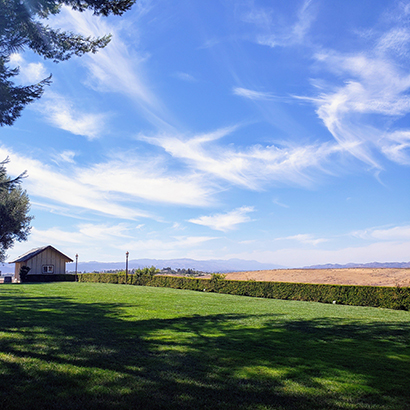Indoor Events

Many rural community events take place inside community buildings and often these buildings are older and have historical significance. In considering rural accessibility, it is important to find ways to balance the needs of people with disabilities with the desire to preserve community history.
Here are a number of things to consider, with some ideas for how to find solutions to meet everyone’s needs.
One event we visited took place in a historical ghost town.
Although no-step back entries had been created during the ‘90s after the passage of the ADA, only one person we talked to knew about them. Several others shared that they couldn’t go into the buildings and that they found alternatives to enjoying them such as sending a husband in with a camera. The community was resistant to signage because it takes away from the historical nature of the ghost town.
In this situation, an alternative to signage might be having several accessibility ambassadors to let people know about the accessible entries sprinkled across the town dressed in frontier style clothing like the other volunteers.
CAARE- Indoor Events
Not only is accessible parking necessary for people with disabilities, having a clearly marked passenger drop-off area and clear pathways to entrances makes it easier for older people and for people with small children in strollers to get into your event.
|
Accessibility considerations: |
Link for more information: |
|---|---|
|
Enough accessible parking |
|
|
Accessible parking is clearly marked |
|
|
Passenger drop-off area near accessible entrance |
|
|
Level and unobstructed pathways from parking area to entrances |
Everyone needs to be able to have a restroom they can easily access and use. Make sure bathrooms have clear signs, and are easy to get to.
|
Accessibility considerations: |
Link for more information: |
|---|---|
|
Accessible bathrooms onsite |
|
|
Clear signage for accessible bathrooms |
|
|
Path to bathroom unobstructed and wheelchair accessible |
Clear walkways benefit everyone, not just people with disabilities. Parents with strollers or small children, older adults, and other groups will also appreciate having safe and unblocked walkways.
|
Accessibility considerations: |
Link for more information: |
|---|---|
|
Clear and unobstructed pathways to all activities and services |
|
|
Ramps at all steps or uneven surfaces |
|
|
Handrails on each side of all stairways |
If people can’t get in, they can’t participate. Make sure everyone can access your event.
|
Accessibility considerations: |
Link for more information: |
|---|---|
|
Door handles are levers or u-shaped |
|
|
No revolving doors |
|
|
Doorways wide enough for walkers, wheelchairs, and other mobility equipment |
|
|
Clear signage directing visitors to accessible entrances |
|
|
Ramps at doors with steps |
|
|
Handrails on both sides of ramps |
|
|
Ground signals and braille to help people with visual impairments to find accessible entrances |
|
|
Make sure nothing is blocking entrances so those using scooters, wheelchairs, or other mobility equipment can use entrance |
Once people are inside your event, make sure they can easily and safely get to every room. Each room and event needs to be set up in a way so that everyone can access the presentation, vendor booths, or displays.
|
Accessibility considerations: |
Link for more information: |
|---|---|
|
Clear and accessible signs leading to rooms with accessible entrances |
|
|
Elevators near entrances to rooms |
|
|
Accessible seating set up in in a way that is inclusive |
|
|
Front row seating for people with vision and hearing impairments |
|
|
ASL interpreters are visible to all attendees |
|
|
Hearing assistance technology is available |
|
|
Microphones for the audience during Q&A sessions |
|
|
Electrical outlets near seating areas |
|
|
Water bowls for service animals and space for toileting |
|
|
Tables are at the appropriate height and have enough space for people using wheelchairs and scooters |
|
|
Materials and/or food are at a height accessible for people using wheelchairs or scooters |
If your event has any speakers, videos, or other types of presentations, different types of accommodations need to be made available.
|
Accessibility considerations: |
Link to more information: |
|---|---|
|
All video presentations have closed captions |
|
|
Interpreters for any needed language, including ASL, available for all activities |
|
|
All media and materials are in accessible formats |
|
|
Areas are well lit and have adjustable lighting |
Some people who use service animals also use mobility equipment, such as a wheelchair or scooter. Make sure service animal areas are also accessible for mobility equipment users.
|
Accessibility considerations: |
Link to more information: |
|---|---|
|
Accessible toileting area |
|
|
Water bowls |
|
|
Hallways and aisles are wide enough to accommodate mobility equipment and service animals |
|
|
Adequate space in sitting areas for service animals |
It’s all about the food! Sharing meals together are an important part of many community events. It’s important to make sure that everyone is included at the table- and that they can get to the table.
|
Accessibility considerations: |
Link to more information: |
|---|---|
|
Chairs with arms available |
|
|
Specialty diets and food sensitivities are accommodated |
|
|
Labels and allergy warnings are clear and obvious, and and are labeled with accessible signs. |
|
|
Food that can be eaten without utensils is available |
|
|
Seating is separate from the food serving area, and able to be rearranged |
